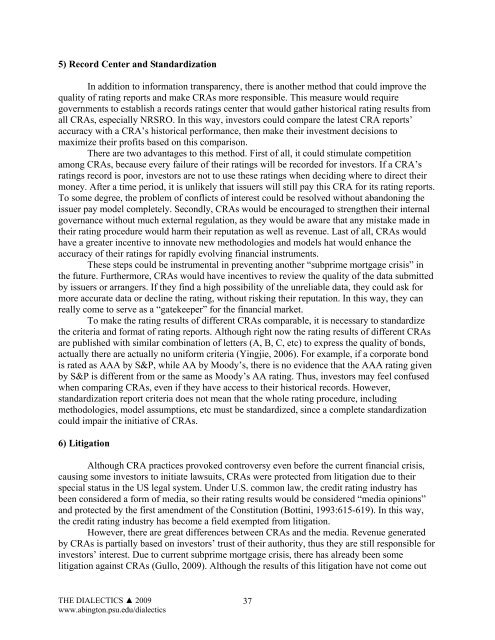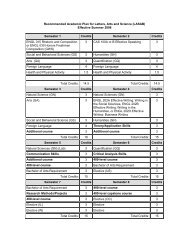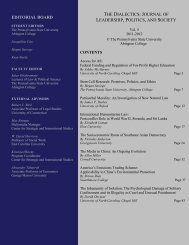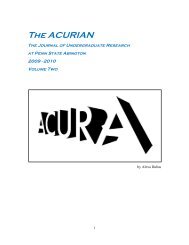Vol. III - Penn State Abington
Vol. III - Penn State Abington
Vol. III - Penn State Abington
Create successful ePaper yourself
Turn your PDF publications into a flip-book with our unique Google optimized e-Paper software.
5) Record Center and Standardization<br />
In addition to information transparency, there is another method that could improve the<br />
quality of rating reports and make CRAs more responsible. This measure would require<br />
governments to establish a records ratings center that would gather historical rating results from<br />
all CRAs, especially NRSRO. In this way, investors could compare the latest CRA reports’<br />
accuracy with a CRA’s historical performance, then make their investment decisions to<br />
maximize their profits based on this comparison.<br />
There are two advantages to this method. First of all, it could stimulate competition<br />
among CRAs, because every failure of their ratings will be recorded for investors. If a CRA’s<br />
ratings record is poor, investors are not to use these ratings when deciding where to direct their<br />
money. After a time period, it is unlikely that issuers will still pay this CRA for its rating reports.<br />
To some degree, the problem of conflicts of interest could be resolved without abandoning the<br />
issuer pay model completely. Secondly, CRAs would be encouraged to strengthen their internal<br />
governance without much external regulation, as they would be aware that any mistake made in<br />
their rating procedure would harm their reputation as well as revenue. Last of all, CRAs would<br />
have a greater incentive to innovate new methodologies and models hat would enhance the<br />
accuracy of their ratings for rapidly evolving financial instruments.<br />
These steps could be instrumental in preventing another “subprime mortgage crisis” in<br />
the future. Furthermore, CRAs would have incentives to review the quality of the data submitted<br />
by issuers or arrangers. If they find a high possibility of the unreliable data, they could ask for<br />
more accurate data or decline the rating, without risking their reputation. In this way, they can<br />
really come to serve as a “gatekeeper” for the financial market.<br />
To make the rating results of different CRAs comparable, it is necessary to standardize<br />
the criteria and format of rating reports. Although right now the rating results of different CRAs<br />
are published with similar combination of letters (A, B, C, etc) to express the quality of bonds,<br />
actually there are actually no uniform criteria (Yingjie, 2006). For example, if a corporate bond<br />
is rated as AAA by S&P, while AA by Moody’s, there is no evidence that the AAA rating given<br />
by S&P is different from or the same as Moody’s AA rating. Thus, investors may feel confused<br />
when comparing CRAs, even if they have access to their historical records. However,<br />
standardization report criteria does not mean that the whole rating procedure, including<br />
methodologies, model assumptions, etc must be standardized, since a complete standardization<br />
could impair the initiative of CRAs.<br />
6) Litigation<br />
Although CRA practices provoked controversy even before the current financial crisis,<br />
causing some investors to initiate lawsuits, CRAs were protected from litigation due to their<br />
special status in the US legal system. Under U.S. common law, the credit rating industry has<br />
been considered a form of media, so their rating results would be considered “media opinions”<br />
and protected by the first amendment of the Constitution (Bottini, 1993:615-619). In this way,<br />
the credit rating industry has become a field exempted from litigation.<br />
However, there are great differences between CRAs and the media. Revenue generated<br />
by CRAs is partially based on investors’ trust of their authority, thus they are still responsible for<br />
investors’ interest. Due to current subprime mortgage crisis, there has already been some<br />
litigation against CRAs (Gullo, 2009). Although the results of this litigation have not come out<br />
THE DIALECTICS ▲ 2009<br />
www.abington.psu.edu/dialectics<br />
37







